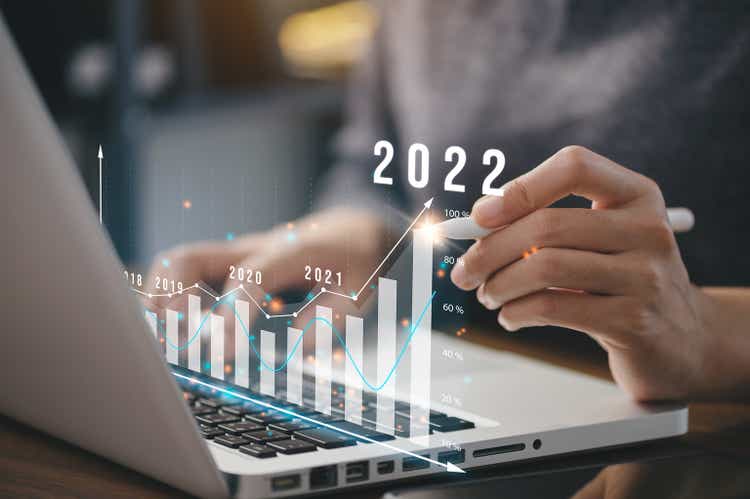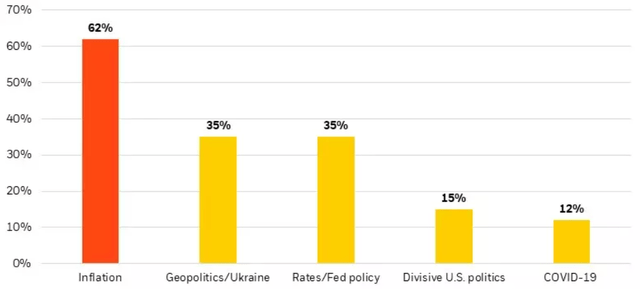Khanchit Khirisutchalual/iStock via Getty Images
By Tony DeSpirito
Buy low, sell high. The age-old wisdom can run counter to human instinct when markets are in a tailspin. But history is instructive, and it tells us that times of pain can be ideal moments to position for future gains. As the second half begins, we see:
- Market direction driven by Fed machinations
- Need for diversification and resilience in equity portfolios
- An underappreciated opportunity in healthcare stocks
Market Overview And Outlook
The first five months of the year marked the worst start for the S&P 500 since 1970 ― and the sixth worst back to 1928.* While caution is warranted, we believe the equity risk premium (ERP) continues to make a case for equities.
Stock valuations have come down, but company earnings remain solid. This keeps the ERP ― which compares the earnings yield on the S&P 500 to bond yields ― above its historical average. Our models suggest the 10-year Treasury yield would have to rise to 4% or earnings decline by more than 20% for the perceived “margin of safety” in stocks over bonds to disappear. Earnings will slow, but 20% is hard to imagine, even in a recession. The average earnings drop in prior recessions was 13%, with the Global Financial Crisis (GFC) skewing the results. See chart below.
All eyes on earnings
S&P 500 earnings decline in recessions, 1957-2020
Source: BlackRock Fundamental Equities, with data from Bloomberg as of June 2022. Earnings decline calculated for the S&P 500 Index of large-cap U.S. stocks starting from the earnings peak prior to the recession and ending with the recession period earnings trough. Recessions as defined by the National Bureau of Economic Research from 1957 to 2020. Indexes are unmanaged. It is not possible to invest directly in an index.
Playing Offense Through Defense
While it is important to maintain a long-term lens, particularly when investing for long-term goals, it is also prudent to protect and position portfolios for the prevailing environment ― a key advantage of active management. Today’s uncertainty argues for a focus on stability and resilience.
Waiting On The Fed
The Fed’s ability to raise interest rates and reduce its balance sheet in a way that neither inflames inflation nor stifles economic growth will have significant bearing on the market backdrop. We are not calling for a recession, but we are cognizant that the risks of a recession are rising: The Fed is tightening monetary policy, bringing an end to “easy money” policies; 30-year mortgage rates have climbed from 3% last year to nearly 6% today; inflation is beginning to erode household savings; and inventories of goods are elevated as both pandemic-induced supply shortages and voracious demand ease.
If the Fed tightens too much, the result could be a recession. If it tightens too little, inflation is the greater threat. The ideal scenario runs in the middle, allowing for a soft landing as policy transitions.
We are not placing odds on any particular outcome, but are generally positioning more defensively. The optimal portfolio to combat inflation is very different from the optimal portfolio for a recession. We advocate using a barbell strategy to position for these competing outcomes. This includes owning energy and financials as inflation fighters, and healthcare for a dose of resilience. We find other traditionally defensive sectors, including utilities and staples, to be expensive relative to the broader market.
The Weight Of Inflation
Notably, our analysis of sector dynamics during the Great Inflation period of the 1970s found energy, financials and healthcare to be the top performers. While the backdrop is different today, we do believe these three sectors could outpace the broader market once again, with financials potentially doing even better in this cycle given stronger bank balance sheets after restructuring and rigorous stress testing in the wake of the GFC.
Inflation surfaced as the perceived greatest risk to equity markets over the next six months in a BlackRock Fundamental Equities survey of more than 1,000 U.S. investors. See chart below. What are Americans doing in the face of higher prices? 50% reported reducing their discretionary spending, while 26% said they have made no changes.
Inflation seen as biggest risk to stocks
Top-five concerns among investors surveyed, May 2022
Source: BlackRock Fundamental Equities, survey conducted May 2022 of 1,091 Americans aged 25+ with a minimum of $250,000 in investible assets. Question posed: What do you see as the biggest risk(s) facing U.S. stock/equity markets in the next six months? Respondents could select two choices of nine provided.
At times like this, the instinct may be to exit the markets. But starting points matter ― and we just got a better entry price.
Maintaining A Long-Term Lens
Uncertainty is high, and daily volatility can test investors’ fortitude. We believe these are the moments when active, fundamental-based stock selection and thoughtful portfolio construction can provide a measure of solace and have a profound impact in the pursuit of long-term financial goals.
* Based on BlackRock Fundamental Equities analysis of index data, sourced from Bloomberg as of June 6, 2022. The S&P 500 was down 13% year-to-date through May 2022 vs. 16% over the same period in 1970.
This material is provided for educational purposes only and is not intended to be relied upon as a forecast, research or investment advice, and is not a recommendation, offer or solicitation to buy or sell any securities or to adopt any investment strategy. The opinions expressed are as of June 2022, and may change as subsequent conditions vary. The information and opinions contained in this material are derived from proprietary and nonproprietary sources deemed by BlackRock to be reliable, are not necessarily all-inclusive and are not guaranteed as to accuracy. Past performance is no guarantee of future results. There is no guarantee that any forecasts made will come to pass. Reliance upon information in this material is at the sole discretion of the reader. The material was prepared without regard to specific objectives, financial situation or needs of any investor.
This material may contain “forward-looking” information that is not purely historical in nature. Such information may include, among other things, projections, forecasts, estimates of yields or returns, and proposed or expected portfolio composition. Moreover, where certain historical performance information of other investment vehicles or composite accounts managed by BlackRock, Inc. and/or its subsidiaries (together, “BlackRock”) has been included in this material, such performance information is presented by way of example only. No representation is made that the performance presented will be achieved, or that every assumption made in achieving, calculating or presenting either the forward-looking information or the historical performance information herein has been considered or stated in preparing this material. Any changes to assumptions that may have been made in preparing this material could have a material impact on the investment returns that are presented herein by way of example.
Investing involves risk. Equities may decline in value due to both real and perceived general market, economic, and industry conditions. Diversification does not ensure profits or protect against loss.
You should consider the investment objectives, risks, charges and expenses of any BlackRock mutual fund carefully before investing. The prospectus and, if available, the summary prospectus contain this and other information about the fund and are available, along with information on other BlackRock funds, by calling 800-882-0052 or from your financial professional. The prospectus should be read carefully before investing.
Prepared by BlackRock Investments, LLC, member FINRA.
Not FDIC Insured | May Lose Value | No Bank Guarantee
© 2022 BlackRock, Inc. All Rights Reserved. BLACKROCK is a trademark of BlackRock, Inc. All other trademarks are those of their respective owners.
USRRMH0622U/S-2256859
This post originally appeared on the iShares Market Insights.
Editor’s Note: The summary bullets for this article were chosen by Seeking Alpha editors.




Be the first to comment